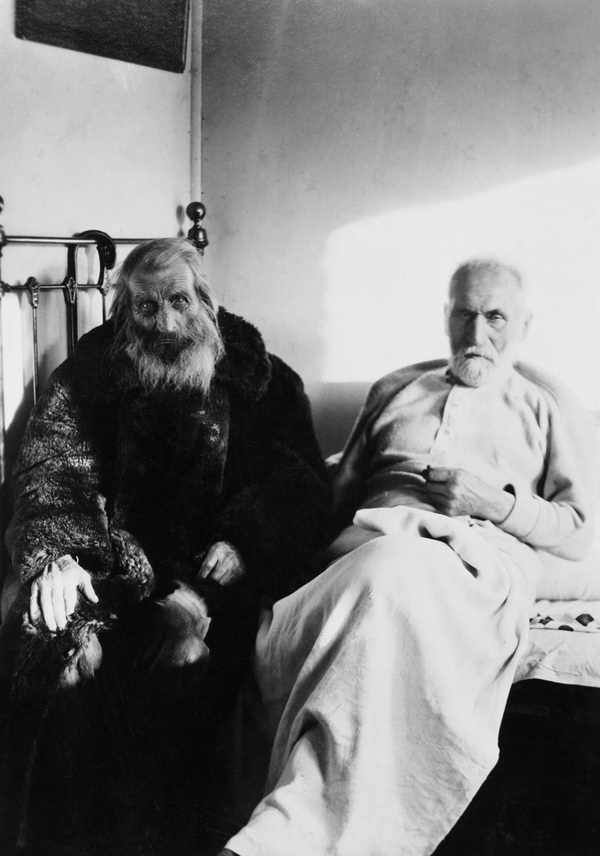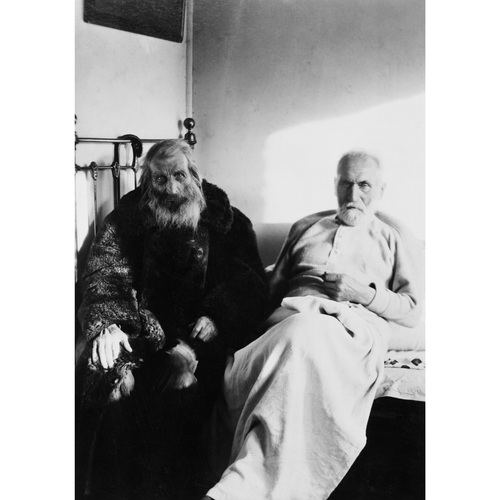
Source: Link
NAULT, ANDRÉ, buffalo hunter, farmer, and captain of the Métis; b. 20 April 1830 in Point Douglas (Winnipeg), son of Amable Nault and Josette (Josephite, Josephte) Lagimodière, known as La Cyprès; grandson of Jean-Baptiste Lagimonière* and Marie-Anne Gaboury*; m. 11 Jan. 1850 Anastasie Landry, and they had 14 children; d. 17 Dec. 1924 in St Vital, Man.
Although André Nault’s parents were of French Canadian origin, they had become integrated into the Métis community of the Red River settlement (Man.). As a young man, Nault accompanied his father on buffalo hunts to the Missouri plateau, excelling as a horseman and hunter. He obtained river lot 12 in St Vital and farmed there. On 17 May 1849, at age 19, he supported the Métis drive for free trade at the famous trial of Pierre-Guillaume Sayer* by marching “with a rifle at his shoulder.” Judge and historian Louis-Arthur Prud’homme* states that this episode was his apprenticeship as a “defender of the rights and liberties of the country’s population.”
The first event of the Métis resistance of 1869-70 to the transfer of Rupert’s Land to the Canadian government was the stopping of the surveyors on 11 Oct. 1869. Oral history suggests that this event occurred on Nault’s river lot in St Vital, but the notebook of surveyor Adam Clark Webbe would seem to indicate that it was on an adjoining lot. Nault’s first name is not listed among those of the seven Naults who were present, but the one nicknamed Nanin is assumed to have been him. On the arrival of the surveyors, Nault is said to have gone for his first cousin Métis leader Louis Riel*, who spoke English. It seems likely that Nault played a significant role on this occasion since oral accounts of the event link it to his property.
According to Nault, at a meeting of the Métis on 21 Oct. 1869 Riel ordered him to construct a barrier at St Norbert to prevent the lieutenant governor designate, William McDougall*, from entering the Red River settlement or bringing in arms. Nault had about 250 to 300 men with him. On 1 November he and his brother Benjamin forced McDougall’s representatives, Captain Donald Roderick Cameron and Joseph-Alfred-Norbert Provencher*, to return to Pembina (N.Dak.). The following day, under Riel’s orders, he and his men captured Upper Fort Garry (Winnipeg) to prevent it from falling into the hands of John Christian Schultz* and his Canadian supporters. From 4 to 23 Dec. 1869 Nault occupied Fort Pembina, the HBC post just north of the international border, to watch the activities of McDougall. When McDougall headed back east, Nault returned to the Red River settlement.
Prud’homme argues that in Riel’s provisional government Nault was probably fourth in line of importance after Riel, Ambroise-Dydime Lépine, and Elzéar Goulet*. Nault was a member of the court martial that on 3 March 1870 tried Thomas Scott*, an Ontarian captured in mid February. Scott had proved to be a particularly troublesome prisoner and was sentenced to execution. Nault, who commanded the Métis firing squad, would report in 1923 to historian Auguste-Henri de Trémaudan that Scott “did not believe that we would have the pluck, as he called it, to go the whole length and to shoot him.” Scott “would pledge his word to keep the peace in order to be released, then break it as soon as he was free. We had no desire whatever to put him to death, he simply forced us to it.”
After troops arrived in August 1870 under the command of Colonel Garnet Joseph Wolseley*, numerous Métis suffered reprisals. In February 1871 Nault was attacked by soldiers at Pembina and left for dead. Prud’homme observed that he carried the scar from this brutal incident until his death. Later in 1871 Nault played a significant role in obtaining information for Riel and the Métis on the movements of William Bernard O’Donoghue*, who had asked Métis leaders, Nault included, for support in attacking Manitoba with a band of Fenians. Nault and Jean-Baptiste Lépine* went to Pembina on 2 October and returned four days later to report that O’Donoghue was planning to attack Fort Pembina before approaching Fort Garry. The Métis under Riel stayed loyal to Canada and did not join O’Donoghue.
In late 1871 Riel suggested the formation of an association of Métis to maintain their influence in the Red River parishes and he looked to Nault as one of the “principal Métis.” Nault was named a councillor of the new organization, the Union Saint-Alexandre. Despite the hopes of Métis leaders that their demonstration of loyalty in protecting the colony against the Fenians would help them obtain amnesty for acts carried out during the resistance, they remained disappointed. Nault was arrested in February 1874. He stood trial for the murder of Scott the following November, but the jury was unable to reach a verdict. He was in prison awaiting a second trial when the government of Alexander Mackenzie* granted a full amnesty to all except Riel, A. D. Lépine, and O’Donoghue in February 1875. His imprisonment left him with heart and lung problems. After his release he returned to his St Vital farm, where he would live until age 94. He took no part in the events of 1885 in Saskatchewan [see Riel], but three of his sons did. He became a member of the Union Nationale Métisse Saint-Joseph du Manitoba, established in 1887 to preserve Métis heritage and culture. An example of his efforts to collect and document Métis history was his donation in 1910 of the original flag of the Union Nationale Métisse to the organization; it is now preserved in the Heritage Centre of the Société Historique de Saint-Boniface. The Métis and francophone communities of Manitoba and André Nault’s numerous descendants continue to honour the memory of this man who was an eye-witness to, and participant in, many stirring events.
Information regarding the flag of the Union Nationale Métisse was given to the authors by Augustine Abraham (Winnipeg) and Agnes Roy (St Vital, Man.) during telephone conversations in the spring of 2001.
AM, MG 3, B18; NR 0157. “The execution of Thomas Scott,” ed. A.-H. de Trémaudan, CHR, 6 (1925): 222-36. A.-G. Morice, Dictionnaire historique des Canadiens et des Métis français de l’Ouest (Québec et Montréal, 1908). L.-A. Prud’homme, “André Nault,” RSC, Trans., 3rd ser., 22 (1928), sect.i: 99-111. Louis Riel, The collected writings of Louis Riel, ed. G. F. G. Stanley (5v., Edmonton, 1985). N. E. A. Ronaghan, “The Archibald administration in Manitoba – 1870–1872” (phd thesis, Univ. of Manitoba, Winnipeg, 1986). G. F. G. Stanley, Louis Riel (Toronto, 1963). A.-H. de Trémaudan, “Louis Riel and the Fenian raid of 1871,” CHR, 4 (1923): 132–44.
Cite This Article
Ruth Swan and Janelle Reynolds, “NAULT, ANDRÉ,” in Dictionary of Canadian Biography, vol. 15, University of Toronto/Université Laval, 2003–, accessed April 2, 2025, https://www.biographi.ca/en/bio/nault_andre_15E.html.
The citation above shows the format for footnotes and endnotes according to the Chicago manual of style (16th edition). Information to be used in other citation formats:
| Permalink: | https://www.biographi.ca/en/bio/nault_andre_15E.html |
| Author of Article: | Ruth Swan and Janelle Reynolds |
| Title of Article: | NAULT, ANDRÉ |
| Publication Name: | Dictionary of Canadian Biography, vol. 15 |
| Publisher: | University of Toronto/Université Laval |
| Year of revision: | 2005 |
| Access Date: | April 2, 2025 |



